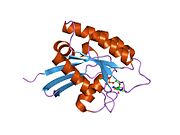MRAS
| MRAS | |||
|---|---|---|---|
Gene ontology | |||
| Molecular function | |||
| Cellular component | |||
| Biological process | |||
| Sources:Amigo / QuickGO | |||
Ensembl | |||||||||
|---|---|---|---|---|---|---|---|---|---|
| UniProt | |||||||||
| RefSeq (mRNA) |
| ||||||||
| RefSeq (protein) |
| ||||||||
| Location (UCSC) | Chr 3: 138.35 – 138.41 Mb | Chr 9: 99.27 – 99.32 Mb | |||||||
| PubMed search | [3] | [4] | |||||||
| View/Edit Human | View/Edit Mouse |
Ras-related protein M-Ras, also known as muscle RAS oncogene homolog and R-Ras3, is a
Structure
Gene
The MRAS gene resides on chromosome 3 at the band 3q22.3 and includes 10
Protein
M-Ras is a member of the
Function
The MRAS gene is expressed specifically in
Clinical significance
In humans, other members of the Ras subfamilies carry mutations in human cancers.[25] Furthermore, the Ras proteins are not only involved in tumorigenesis but also in many developmental disorders.[25] For instance, the Ras-related proteins appear to be overexpressed in human carcinomas of the oral cavity, esophagus, stomach, skin, and breast, as well as in lymphomas.[26][27][28][29] More currently, Ras family members such as R-RAS, R-RAS2 and also R-RAS3 have also been implicated as main factors in triggering neural transformation, with R-RAS2 as the most significant element.[30]
Clinical marker
A multi-locus genetic risk score study based on a combination of 27 loci, including the MRAS gene, identified individuals at increased risk for both incidence and recurrent coronary artery disease events, as well as an enhanced clinical benefit from statin therapy. The study was based on a community cohort study (the Malmo Diet and Cancer study) and four additional randomized controlled trials of primary prevention cohorts (JUPITER and ASCOT) and secondary prevention cohorts (CARE and PROVE IT-TIMI 22).[31]
Interactions
MRAS has been shown to
References
- ^ a b c GRCh38: Ensembl release 89: ENSG00000158186 – Ensembl, May 2017
- ^ a b c GRCm38: Ensembl release 89: ENSMUSG00000032470 – Ensembl, May 2017
- ^ "Human PubMed Reference:". National Center for Biotechnology Information, U.S. National Library of Medicine.
- ^ "Mouse PubMed Reference:". National Center for Biotechnology Information, U.S. National Library of Medicine.
- ^ PMID 9400994.
- PMID 10446149.
- ^ a b "Entrez Gene: MRAS muscle RAS oncogene homolog".
- ^ "BioGPS - your Gene Portal System". biogps.org. Retrieved 2016-10-10.[permanent dead link]
- S2CID 25048933.
- PMID 23863483.
- PMID 19800879.
- PMID 24211266.
- PMID 25748612.
- ^ a b "MRAS - Ras-related protein M-Ras precursor - Homo sapiens (Human) - MRAS gene & protein". www.uniprot.org. Retrieved 2016-10-10.
- PMID 15994326.
- ^ S2CID 12357144.
- ^ PMID 9400994.
- PMID 10934204.
- PMID 10446149.
- S2CID 25048933.
- PMID 23863483.
- PMID 19800879.
- PMID 17538012.
- PMID 24211266.
- ^ PMID 18568040.
- PMID 10321735.
- PMID 7936652.
- PMID 8052619.
- PMID 7478545.
- PMID 24148564.
- PMID 25748612.
- S2CID 240243.
- S2CID 40024826.
Further reading
- Matsumoto K, Asano T, Endo T (November 1997). "Novel small GTPase M-Ras participates in reorganization of actin cytoskeleton". Oncogene. 15 (20): 2409–17. S2CID 12357144.
- Louahed J, Grasso L, De Smet C, Van Roost E, Wildmann C, Nicolaides NC, Levitt RC, Renauld JC (September 1999). "Interleukin-9-induced expression of M-Ras/R-Ras3 oncogene in T-helper clones". Blood. 94 (5): 1701–10. PMID 10477695.
- Ehrhardt GR, Leslie KB, Lee F, Wieler JS, Schrader JW (October 1999). "M-Ras, a widely expressed 29-kD homologue of p21 Ras: expression of a constitutively active mutant results in factor-independent growth of an interleukin-3-dependent cell line". Blood. 94 (7): 2433–44. S2CID 40024826.
- Kimmelman AC, Osada M, Chan AM (April 2000). "R-Ras3, a brain-specific Ras-related protein, activates Akt and promotes cell survival in PC12 cells". Oncogene. 19 (16): 2014–22. S2CID 25048933.
- Rebhun JF, Castro AF, Quilliam LA (November 2000). "Identification of guanine nucleotide exchange factors (GEFs) for the Rap1 GTPase. Regulation of MR-GEF by M-Ras-GTP interaction". The Journal of Biological Chemistry. 275 (45): 34901–8. PMID 10934204.
- Gao X, Satoh T, Liao Y, Song C, Hu CD, Kariya Ki K, Kataoka T (November 2001). "Identification and characterization of RA-GEF-2, a Rap guanine nucleotide exchange factor that serves as a downstream target of M-Ras". The Journal of Biological Chemistry. 276 (45): 42219–25. PMID 11524421.
- Ortiz-Vega S, Khokhlatchev A, Nedwidek M, Zhang XF, Dammann R, Pfeifer GP, Avruch J (February 2002). "The putative tumor suppressor RASSF1A homodimerizes and heterodimerizes with the Ras-GTP binding protein Nore1". Oncogene. 21 (9): 1381–90. S2CID 240243.
- Kimmelman AC, Nuñez Rodriguez N, Chan AM (August 2002). "R-Ras3/M-Ras induces neuronal differentiation of PC12 cells through cell-type-specific activation of the mitogen-activated protein kinase cascade". Molecular and Cellular Biology. 22 (16): 5946–61. PMID 12138204.
- Mitin NY, Ramocki MB, Zullo AJ, Der CJ, Konieczny SF, Taparowsky EJ (May 2004). "Identification and characterization of rain, a novel Ras-interacting protein with a unique subcellular localization". The Journal of Biological Chemistry. 279 (21): 22353–61. PMID 15031288.
- Roberts AE, Araki T, Swanson KD, Montgomery KT, Schiripo TA, Joshi VA, Li L, Yassin Y, Tamburino AM, Neel BG, Kucherlapati RS (January 2007). "Germline gain-of-function mutations in SOS1 cause Noonan syndrome". Nature Genetics. 39 (1): 70–4. S2CID 10222262.
- Yoshikawa Y, Satoh T, Tamura T, Wei P, Bilasy SE, Edamatsu H, Aiba A, Katagiri K, Kinashi T, Nakao K, Kataoka T (August 2007). "The M-Ras-RA-GEF-2-Rap1 pathway mediates tumor necrosis factor-alpha dependent regulation of integrin activation in splenocytes". Molecular Biology of the Cell. 18 (8): 2949–59. PMID 17538012.


